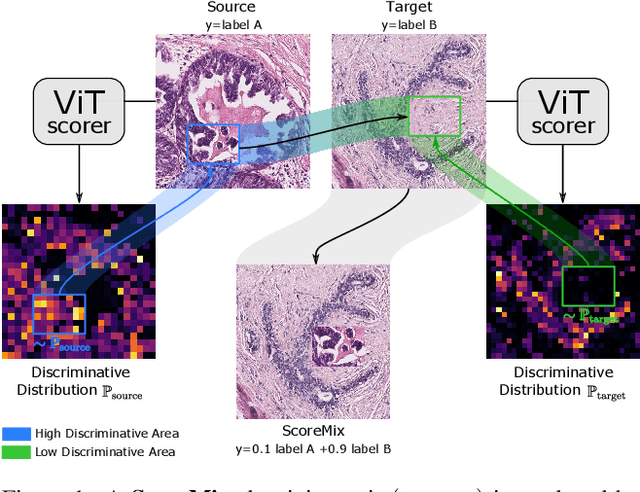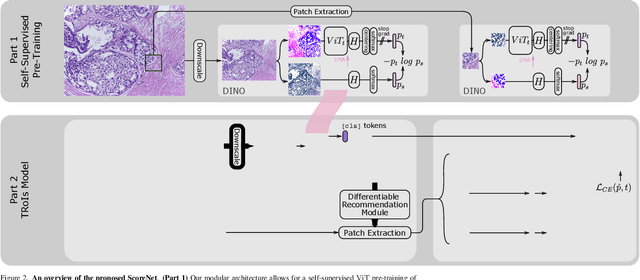Thomas Stegmüller
A Simple Framework for Open-Vocabulary Zero-Shot Segmentation
Jun 23, 2024



Abstract:Zero-shot classification capabilities naturally arise in models trained within a vision-language contrastive framework. Despite their classification prowess, these models struggle in dense tasks like zero-shot open-vocabulary segmentation. This deficiency is often attributed to the absence of localization cues in captions and the intertwined nature of the learning process, which encompasses both image representation learning and cross-modality alignment. To tackle these issues, we propose SimZSS, a Simple framework for open-vocabulary Zero-Shot Segmentation. The method is founded on two key principles: i) leveraging frozen vision-only models that exhibit spatial awareness while exclusively aligning the text encoder and ii) exploiting the discrete nature of text and linguistic knowledge to pinpoint local concepts within captions. By capitalizing on the quality of the visual representations, our method requires only image-caption pairs datasets and adapts to both small curated and large-scale noisy datasets. When trained on COCO Captions across 8 GPUs, SimZSS achieves state-of-the-art results on 7 out of 8 benchmark datasets in less than 15 minutes.
CrIBo: Self-Supervised Learning via Cross-Image Object-Level Bootstrapping
Oct 11, 2023



Abstract:Leveraging nearest neighbor retrieval for self-supervised representation learning has proven beneficial with object-centric images. However, this approach faces limitations when applied to scene-centric datasets, where multiple objects within an image are only implicitly captured in the global representation. Such global bootstrapping can lead to undesirable entanglement of object representations. Furthermore, even object-centric datasets stand to benefit from a finer-grained bootstrapping approach. In response to these challenges, we introduce a novel Cross-Image Object-Level Bootstrapping method tailored to enhance dense visual representation learning. By employing object-level nearest neighbor bootstrapping throughout the training, CrIBo emerges as a notably strong and adequate candidate for in-context learning, leveraging nearest neighbor retrieval at test time. CrIBo shows state-of-the-art performance on the latter task while being highly competitive in more standard downstream segmentation tasks. Our code and pretrained models will be publicly available upon acceptance.
Adaptive Similarity Bootstrapping for Self-Distillation
Mar 23, 2023



Abstract:Most self-supervised methods for representation learning leverage a cross-view consistency objective i.e. they maximize the representation similarity of a given image's augmented views. Recent work NNCLR goes beyond the cross-view paradigm and uses positive pairs from different images obtained via nearest neighbor bootstrapping in a contrastive setting. We empirically show that as opposed to the contrastive learning setting which relies on negative samples, incorporating nearest neighbor bootstrapping in a self-distillation scheme can lead to a performance drop or even collapse. We scrutinize the reason for this unexpected behavior and provide a solution. We propose to adaptively bootstrap neighbors based on the estimated quality of the latent space. We report consistent improvements compared to the naive bootstrapping approach and the original baselines. Our approach leads to performance improvements for various self-distillation method/backbone combinations and standard downstream tasks. Our code will be released upon acceptance.
CrOC: Cross-View Online Clustering for Dense Visual Representation Learning
Mar 23, 2023



Abstract:Learning dense visual representations without labels is an arduous task and more so from scene-centric data. We propose to tackle this challenging problem by proposing a Cross-view consistency objective with an Online Clustering mechanism (CrOC) to discover and segment the semantics of the views. In the absence of hand-crafted priors, the resulting method is more generalizable and does not require a cumbersome pre-processing step. More importantly, the clustering algorithm conjointly operates on the features of both views, thereby elegantly bypassing the issue of content not represented in both views and the ambiguous matching of objects from one crop to the other. We demonstrate excellent performance on linear and unsupervised segmentation transfer tasks on various datasets and similarly for video object segmentation. Our code and pre-trained models are publicly available at https://github.com/stegmuel/CrOC.
Self-Supervised Learning-Based Cervical Cytology Diagnostics in Low-Data Regime and Low-Resource Setting
Feb 10, 2023



Abstract:Screening Papanicolaou test samples effectively reduces cervical cancer-related mortality, but the lack of trained cytopathologists prevents its widespread adoption in low-resource settings. Developing AI algorithms, e.g., deep learning to analyze the digitized cytology images suited to resource-constrained countries is appealing. Albeit successful, it comes at the price of collecting large annotated training datasets, which is both costly and time-consuming. Our study shows that the large number of unlabeled images that can be sampled from digitized cytology slides make for a ripe ground where self-supervised learning methods can thrive and even outperform off-the-shelf deep learning models on various downstream tasks. Along the same line, we report improved performance and data efficiency using modern augmentation strategies.
ScoreNet: Learning Non-Uniform Attention and Augmentation for Transformer-Based Histopathological Image Classification
Mar 14, 2022



Abstract:Progress in digital pathology is hindered by high-resolution images and the prohibitive cost of exhaustive localized annotations. The commonly used paradigm to categorize pathology images is patch-based processing, which often incorporates multiple instance learning (MIL) to aggregate local patch-level representations yielding image-level prediction. Nonetheless, diagnostically relevant regions may only take a small fraction of the whole tissue, and current MIL-based approaches often process images uniformly, discarding the inter-patches interactions. To alleviate these issues, we propose ScoreNet, a new efficient transformer that exploits a differentiable recommendation stage to extract discriminative image regions and dedicate computational resources accordingly. The proposed transformer leverages the local and global attention of a few dynamically recommended high-resolution regions at an efficient computational cost. We further introduce a novel Mixup-based data-augmentation, namely ScoreMix, by leveraging the image's semantic distribution to guide the data mixing and produce coherent sample-label pairs. ScoreMix is embarrassingly simple and mitigates the pitfalls of previous augmentations, which assume a uniform semantic distribution and risk mislabeling the samples. Thorough experiments and ablation studies on three breast cancer histology datasets of Haematoxylin & Eosin (H&E) have validated the superiority of our approach over prior arts, including transformer-based models on tumour regions-of-interest (TRoIs) classification. ScoreNet equipped with proposed ScoreMix augmentation demonstrates better generalization capabilities and achieves new state-of-the-art (SOTA) results with only 50% of the data compared to other Mixup augmentation variants. Finally, ScoreNet yields high efficacy and outperforms SOTA efficient transformers, namely TransPath and SwinTransformer.
 Add to Chrome
Add to Chrome Add to Firefox
Add to Firefox Add to Edge
Add to Edge